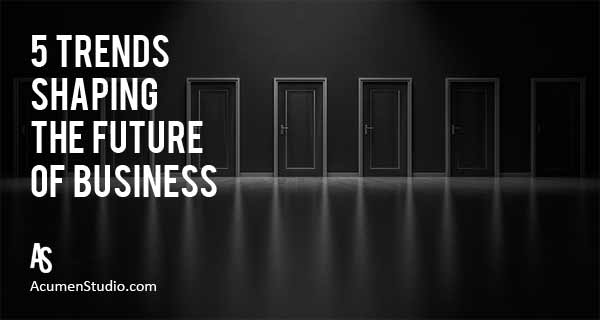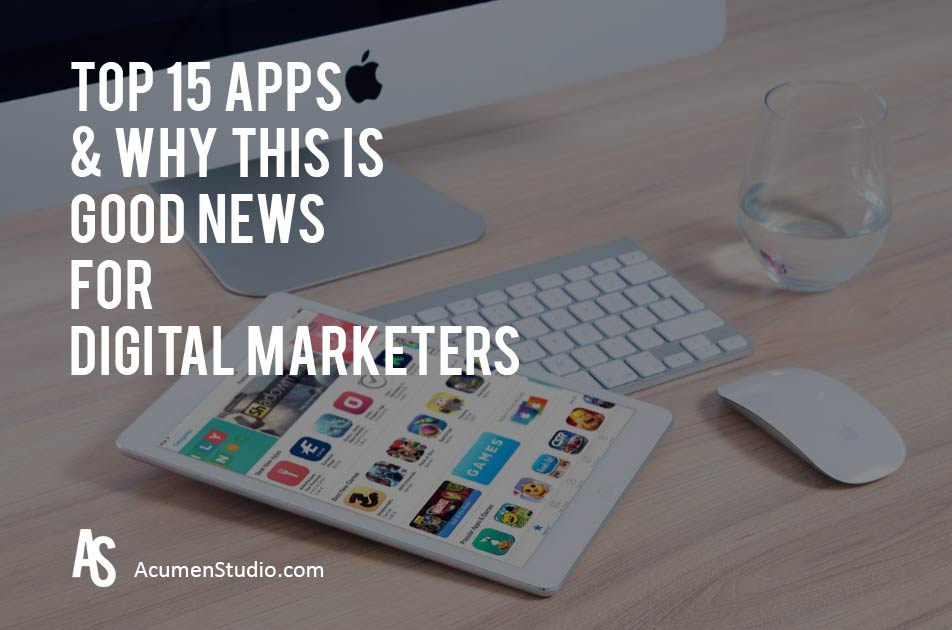
5 Trends Shaping the Future of Business
I recently read an article by John Rampton titled “Prepare for the Future being shaped by these 5 Critical Trends.”
He goes on to share these trends and his explanation of why they will have a significant impact on the future.
Some of it I agreed with while other parts I did not.
Here I am sharing both my opinions and ideas in comparison to Rampton’s.
5 Trends Shaping the Future of Business (and Marketing)
1. Winning at mobile will mean having an app.
Rampton
Mobile usage is at an all-time high and shows no signs of slowing down. Consumers are using mobile for everything from buying products, to communicating with friends, to playing games, to finding local businesses.
Over the past couple of years, business owners have taken this trend to heart, optimizing their sites for mobile through the use of a responsive site design. And while this is a great first step, it may no longer be enough to future-proof your business.
Research shows that 89 percent of all mobile media time is now spent in apps, while only the remaining 11 percent is spent on the mobile web. This means that not having an app for your business is almost certainly costing you. If you don’t already have an app, now is the time to start planning for one.
Bracamontes
While I agree with what most of Rampton is saying here, I cannot make the same absolute statement that All businesses will need a mobile app. I am a big supporting of the mobile web and responsive design.
The research that showcases 89% of mobile media time is spent in apps is skewed heavily toward consumers playing games, watching YouTube videos and messaging other consumers. So unless you are one of those types of companies, then there are larger questions to ask in determining your need for an app.
We have had many companies come to us with ideas for customer portals or app ideas that didn’t need to be an app.
In our opinion, a larger concern will be on integrating with other apps. Aggregators, Indexing and organizational apps will lead heavily in how we interact with our mobile devices, so getting cozy with these companies will be hugely beneficial.
2. Increase your use of freelancers now so you’re not playing catch-up.
Rampton
We now know that 34 percent of the US workforce are freelancers. This works out to over 54 million freelancers in America who contribute $700 billion annually to the national economy.
It has also been predicted that by 2020 (that’s just four years away!), freelancers will make up 50 percent of the workforce. That will seriously impact how you do business!
There are many benefits to using freelancers to build and grow your business. However, one of the most important “future-proof” benefits is this: in the event of an economic downturn, using freelancers will make you and your business far more nimble. Not only will it allow you to find and hire the best global workers, you won’t need to pay costs like office space or employee benefits.
Bracamontes
Definitely agree with Rampton here.
While again these numbers are skewed since many of these freelancers are also fully employed, it doesn’t negate the fact that they are still doing some work on a freelance basis.
Every study is showing that more and more people are moving to work in a freelance capacity, due to the freedom it can provide for their lifestyle.
Is this good for business, maybe, maybe not, but it is a fact that you will have to be a part of this trend.
3. Prepare for the aging workforce.
Rampton
The US workforce is undergoing some serious shifts in terms of demographics. In fact, according to the CDC, by 2020 one in every four workers will be over the age of 55.
As older workers begin retiring, companies will be left with openings in key leadership positions. To fill these gaps, businesses will need to consider whether to hire internally or externally. While smaller organizations may need to look almost exclusively to outside hires, the “world’s most admired companies” (WMAC’s) know that hiring internally is the wave of the future. According to Fortune, only 11 percent of WMAC’s anticipate hiring externally, while 81 percent say they’re preparing current employees to take over key positions.
Now is the time to begin identifying high-potential individuals within your organization. This will give you time to invest in training and development, ensuring they’re ready for their new roles when the time comes.
Bracamontes
This is an interesting contradiction to the freelancer prediction in my opinion.
With an increase in people moving to freelance, you may find that key leadership roles will actually move outside of the company and be held by those who left.
I can definitely see a retirement package, being a consulting gig for the executive leaving their full time benefit laden gig with a more lean outlay for the company, but still very lucrative and more flexible for the now contracted retiree.
Another trend are SuperTemps, which are basically well educated consultants who work independent of any organization, but are just as good, if not better than those you would find at Deloitte, Bain, Booz, etc.
I can say that personally, we will look both internally and externally for our agency.
It’s ultimately about fit.
4. Adapt policies attractive to millenial employees.
Rampton
According to the Workforce 2020 Global Research report, one of the top concerns organizations have in terms of labor-market shifts is the rise in millennials entering the workforce. And while executives believe there key differences between how Millennials and other generational groups operate in the organization, most don’t fully understand exactly what these differences are.
Millennials are less bound by loyalty, and expect to have up to 9 employers over the course of their lifetime. In their report, Millennials At Work: Reshaping the Workplace, PricewaterhouseCoopers offers some important insights into the differences employers should consider, including:
- Due to recent economic downturn in many parts of the world, Millennials now expect to work for up to six or more employers over their lifetime. This means decreased loyalty toward employers, and therefore greater turnover.
- Millennials value flexibility and diversity in terms of their working hours, location, training and work/life balance.
- Millennials prefer to communicate electronically rather than in-person or on the phone. Employers will need to adapt their current model to accommodate this.
- Millennials prefer a digital wallet over being paid by check. They are demanding a new wave of ease in payments.
Bracamontes
I’ll be honest in saying that this is ridiculous to me in that we have to work hard to make these shifts.
These types of business building activities have progressed since the beginning of time.
Cultures change, behaviors change, rules change, technology changes, etc. and we have to CHANGE TOO!
We see this as being a communication issue with organizations.
Make the shifts like you’re going to have to anyway and convey the message that working with you is good for those reasons.
Who cares how the work gets done as long as it gets done.
And if you are communicating your values and beliefs correctly then you will attract the type of people you want in your organization and they will likely do the work in a similar style as you anyway.
5. Prepare your business for environmental and social sustainability.
Rampton
While becoming socially and environmentally sustainable is currently not a requirement in most industries, it may become so in the future. Beginning the process of becoming a so-called “future-fit” business can help you start the process now, ensuring you continue to grow and thrive into the future, without doing harm to society or the environment. Millennials really care about both of these issues, so you may want to up your own game in both of these social issue areas.
Using the Future-Fit Business benchmark, businesses can define their own future-fit goals to ensure they’re on the path towards becoming sustainable. Businesses can aspire to a list of 21 goals, each with its own set of key fitness indicators (KFIs).
Be aware that pursuing this course can have significant impact on the way you do business. The report authors write, “We believe that when businesses see the gap between their current performance and the necessary future-fit level of environmental and social performance, they will abandon their incremental efforts and embrace innovative breakthrough efforts…Some companies may find that they need to redesign their business model to reach the benchmark and capture the benefits.”
Bracamontes
Look I get it.
The environment is important to keep healthy, because if we don’t, then we die (or our kids, grand kids, great grand kids, etc.).
But social sustainability sounds a little off.
Our society changes a lot and our views change with it.
You could always argue that actions or inactions could positively or negatively affect society.
My opinion is to do what you think is right and value feedback.
As an example: A recent documentary I watched showed how the overwhelming charity given to areas in Africa has actually killed societies, due to the fact that they cannot sustain without these handouts, due to the fact that they get these handouts!
Food given to these African cities, kills the local food economy and puts farmers out of business, clothing given to the cities, kills the local textile manufacturers and clothiers. See what I’m saying.
So something you think is great for society could be really detrimental.
These statements also make me think that we are in some type of a bubble as well.
Needless to say, I like to give my two cents.
I thought there was great thought put into the article and wanted to share with you all as well.
If you want to talk to me about ideas like this then give me a call or send an email and I would love to talk shop with you. Especially if it’s in relation to content marketing or digital marketing audits!
*original source: https://www.entrepreneur.com/article/281097



